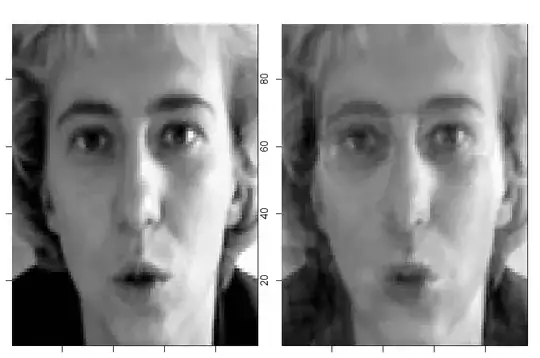I've performed PCA on face images dataset and I'm not sure how can I use the most informative principal components to show the "reduced" image.
The original image is 96*96 pixels (96*96 = 9216) and I use a sample of 70 images here (70 rows and 9216 column). We get 70 principal components (min{num of samples, num of features}=70).
How can I re-construct a 96x96 image in order to show the eigenfaces? I want to show my students how the eigenvectors "predict" the real data.
The dataset I'm using can be downloaded here.
The code:
install.packages("foreach")
file ='C:\\I\\Love\\Data Science\\face.training.csv'
data_all = read.csv(file , stringsAsFactors=F)
dim(data_all) #7049 31
# use only 70 first images
data = data_all[1:70,]
names(data)
str(data)
# extract the images data
im.train <- data$Image
data$Image = NULL
# each image is a vector of 96*96 pixels (96*96 = 9216).
library(foreach)
im.train <- foreach(im = im.train, .combine=rbind) %dopar% {
as.integer(unlist(strsplit(im, " ")))
}
# im.train is a matrix of pixels 70x9216
# show picture number 2
im <- matrix(data=rev(im.train[2,]), nrow=96, ncol=96)
image(1:96, 1:96, im, col=gray((0:255)/255))
# Apply PCA
pca <- prcomp(im.train,
center = TRUE,
scale. = TRUE) ## using correlation matrix
# There are in general min(n − 1, p) informative principal components in a data set with n observations and p variables. Hence, pca$x is 70x70
# Standard deviation of each component
pca$sdev
# A numeric matrix which provides the data for the principal components analysis
pca$x
dim(pca$x)
# The print method returns the standard deviation of each of the PCs,
# and their rotation (or loadings), which are the coefficients of the linear combinations of the continuous variables.
print(pca)
#The summary method describe the importance of the PCs.
summary(pca)
#The first row describe again the standard deviation associated with each PC.
#The second row shows the proportion of the variance in the data explained by each component
#while the third row describe the cumulative proportion of explained variance.
# plot method returns a plot of the variances (y-axis) associated with the PCs (x-axis).
# useful to decide how many PCs to retain for further analysis.
plot(pca, type = "l")
